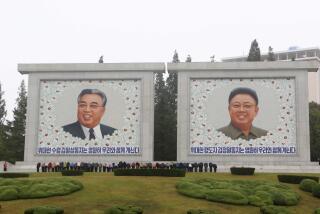Soviets Disclose Size of Chemical Arms Stockpile
- Share via
MOSCOW — The Soviet Union disclosed for the first time Saturday that it has about 50,000 tons of chemical weapons in its arsenal, which it said corresponds to the American arsenal of poisonous substances.
Until earlier this year, the Kremlin never admitted that its armed forces had any chemical weapons, but the revelation of an approximate figure by the Soviet Foreign Ministry in a formal statement may speed negotiation of a Soviet-American treaty to ban production or possession of such toxic materials.
The revelation was combined with a renewed denunciation of the United States for starting production this month of binary chemical weapons, a move Moscow has denounced as “militarist.” Binary weapons combine two relatively harmless agents to form a lethal compound.
May Counter U.S. Action
The Foreign Ministry hinted that the Soviet Union may be forced to produce its own binary weapons if the United States continues to manufacture them.
But Western diplomats said the Kremlin’s decision to disclose the size of the Soviet chemical weapons stockpile could be viewed as a concession to American demands for greater disclosure of what have been viewed in the past as military secrets.
Congress authorized the start of binary weapons production on grounds that the Soviet Union had built up massive stockpiles of arms for chemical warfare while the United States had stopped production.
Soviet leader Mikhail S. Gorbachev and President Reagan agreed at their Washington summit in December to negotiate a “verifiable, comprehensive and effective international convention on the prohibition and destruction of chemical weapons.”
Soviets Express Shock
U.S. production of binary weapons, however, began Dec. 16, less than a week after the summit communique was issued, and Saturday’s Foreign Ministry statement expressed shock and surprise at this post-summit development.
It came after American inspectors went to a Soviet site to witness the destruction of chemical weapons and a Soviet delegation went to the U.S. Army’s chemical weapons arsenal and disposal installation in Tooele, Utah.
The exchange of visits was designed to provide information to both sides about what procedures to establish in a treaty to ban chemical weapons production or use.
While the Soviet side has expressed optimism that talks on banning such weapons are in their final stages, chief U.S. negotiator Max Friedersdorf has said much remains to be done before an agreement can be reached.
Bid to End ‘Deception’
The official statement here Saturday rejected speculation in the West that the Soviet arsenal of chemical weapons exceeds 250,000 tons and might go as high as 700,000 tons.
“It is necessary that an end be put to this deception,” the announcement said. “The Soviet Foreign Ministry is authorized to state that the stocks of chemical weapons in the Soviet Union do not exceed 50,000 tons in terms of poisoning substance.
“According to Soviet expert estimates, this corresponds to the chemical weapons stocks of the United States,” it added. “Moreover, all Soviet chemical weapons are located on Soviet territory.”
‘New Generation’
In its statement, the Soviet Foreign Ministry said the start of binary weapons production marked “a new generation” of chemical arms that would accelerate military competition.
“The Soviet Union halted the production of chemical weapons, never used these weapons, did not turn them into strange hands and did not deploy them outside its borders,” the Foreign Ministry said.
“All these facts demonstrate that the launching of the production of binary chemical weapons in the United States is nothing short of an attempt to torpedo the process of chemical disarmament,” the statement said.
A ban on chemical weapons is a major issue at disarmament talks involving 41 nations in Geneva.
Binary weapons, which represent an advance in chemical warfare, involve the mixing of two harmless substances in a warhead while it speeds toward a target to provide the poisonous effect on impact.
More to Read
Sign up for Essential California
The most important California stories and recommendations in your inbox every morning.
You may occasionally receive promotional content from the Los Angeles Times.










